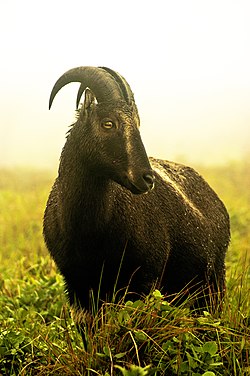Nilgiri tahr
| Nilgiri tahr | |
|---|---|
 |
|
| Scientific classification | |
| Kingdom: | Animalia |
| Phylum: | Chordata |
| Class: | Mammalia |
| Order: | Artiodactyla |
| Family: | Bovidae |
| Subfamily: | Caprinae |
| Genus: |
Nilgiritragus Ropiquet & Hassanin, 2005 |
| Species: | N. hylocrius |
| Binomial name | |
|
Nilgiritragus hylocrius (Ogilby, 1838) |
|
| Synonyms | |
|
Hemitragus hylocrius |
|
Hemitragus hylocrius
The Nilgiri tahr (Nilgiritragus hylocrius) known locally as the Nilgiri ibex or simply ibex, is an ungulate that is endemic to the Nilgiri Hills and the southern portion of the Western Ghats in the states of Tamil Nadu and Kerala in southern India. It is the state animal of Tamil Nadu. Despite its local name, it is more closely related to the sheep of the Ovis genus than the ibex and wild goats of the Capra genus.
In the Tamil language it is called varaiaadu (வரையாடு), the term being composed of two Tamil words, wurrai a precipice, and aadu, a goat.In Malayalam it is pronounced as "Varayaadu" (വരയാട്). The ancient word in classical Tamil was "varudai" (வருடை: Natrinai, 359; Ainkurunuru, 287; Pattinappalai, 139). It was previously named Capra warryato by John Edward Gray.
Its closest relatives are sheep (genus Ovis). Until 2005, it was placed with the Himalayan tahr (Hemitragus jemlahicus) and the Arabian tahr (Arabitragus jayakari) in the genus Hemitragus. However, it has recently been transferred to a new genus Nilgiritragus because it is genetically more similar to members of the genus Ovis than to other tahrs.
The Nilgiri tahr is a stocky goat with short, coarse fur and a bristly mane. Males are larger than females and of darker color when mature. Both sexes have curved horns, reaching up to 40 centimetres (16 in) for males and 30 centimetres (12 in) for females. Adult males weigh 80 to 100 kilograms (180 to 220 lb) and stand about 100 centimetres (39 in) tall at the shoulder. Adult males develop a light grey area on their backs and are thus called "saddlebacks".
...
Wikipedia

